When Jamath Shoffner was appointed as Oostende’s new manager at the beginning of the year, he was brought into a situation that looked all but doomed.
The club had just accrued another six-point deduction for failure to pay wages, and it looked likely they would go bankrupt and fold, rooted to the bottom of the Challenger Pro League.
However, fast-forward to the present day, and Oostende is alive and well.
The club is reportedly getting closer to new ownership and getting confirmation of staying in the second division after beating already relegated Standard Liège II on the last day of the season.
A lot of this success has come from Shoffner, with the 45-year-old American able to galvanise the squad and win some big matches in the Belgian second tier, as well as winning against Pro League side RWDM and advancing to the semi-finals of the Belgian Cup before losing valiantly to current Belgian Pro League champions Antwerp.
The following tactical analysis will examine some of the tactics the former Dudelange manager has implemented at Oostende and how he may be able to guide the team up the table in the 2024/25 season.
Jamath Shoffner Formations
Looking at formations, since Jamath Shoffner’s appointment at the beginning of January, he has normally set Oostende up in a back-five formation, typically a 5-3-2.
This shape tends to shift to a back three when the Belgian side is going forward, as the wing-backs tend to push forward to advance attacks and provide width in the attacking half.
However, Shoffner has also looked to alter shape on occasion, with Oostende opting for a back four in some matches, most notably deploying a 4-1-4-1 against Challenger Pro League champions Beerschot.
This showed an example of Shoffner displaying his tactical flexibility.
Shoffner opted for this formation to control the midfield, the 45-year-old wanting to force Dirk Kuyt’s side to play long and eliminate the strongest area of Beerschot under the Dutchman.
Direct in attack, prioritise attacking with width and long balls centrally
From an attacking perspective, Oostende is a side that does not look to play much with the ball under Jamath Shoffner’s tactics.
Their 44.8% average ball possession this season is the joint second-lowest in the Challenger Pro League.
They will have spells where they hold the majority of possession in a match, but these moments are few and far between, with Oostende normally looking to skip out of the midfield entirely.
KV Oostende Progressive Passes Map
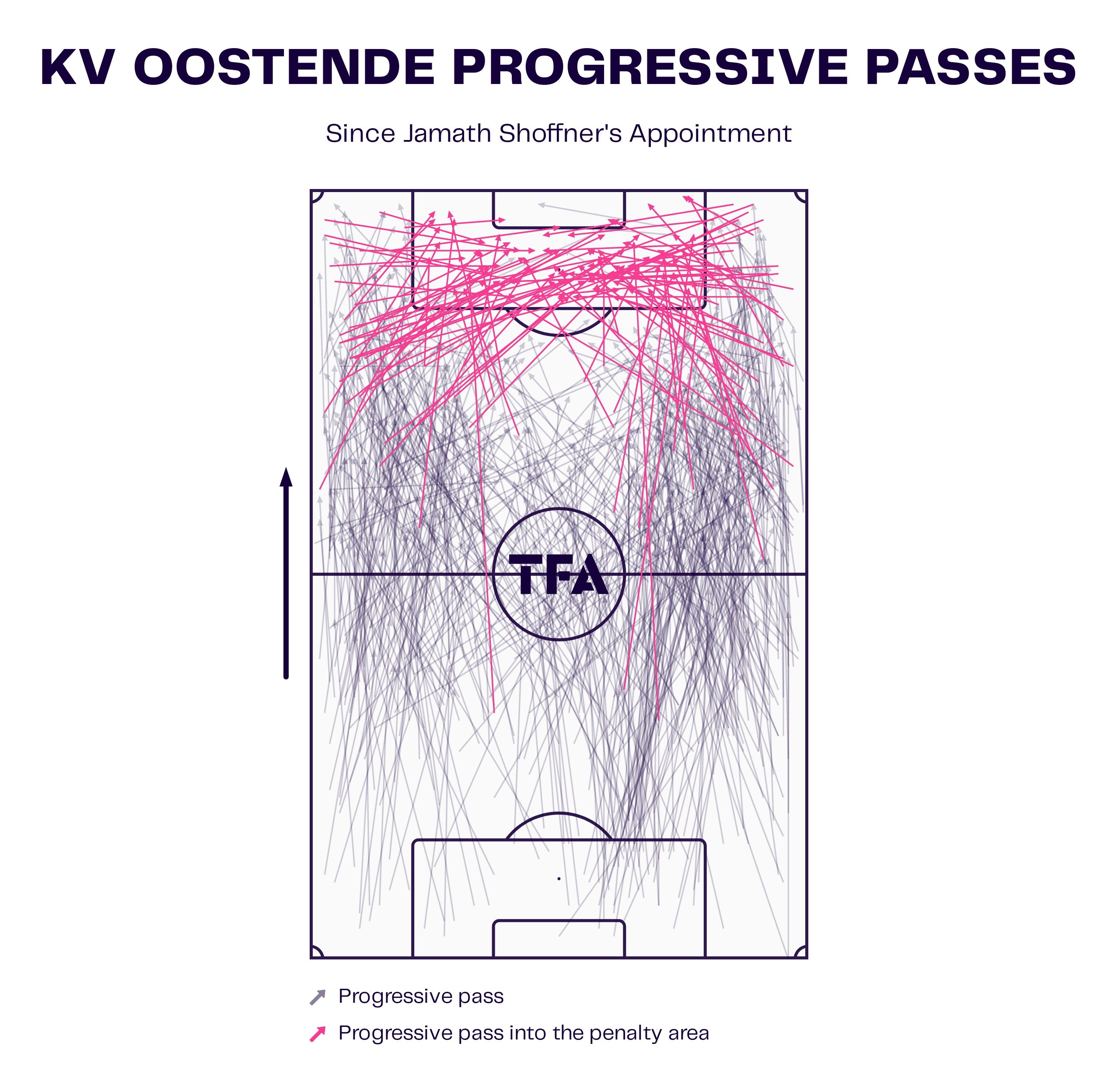
The graphic above shows a more detailed look at Oostende’s progressive passes under Jamath Shoffner’s coaching style.
As we can gather from the data, the central areas in the attacking third and middle third of the pitch do not see much ball progression, with the wide areas being where the ball tends to be played when it is in possession of the centre-backs.
This is where the wing-backs in Shoffner’s system are so important.
If the ball is not played directly to the forwards, it tends to find its way out to the wing-backs, who provide the width and get forward in attack.
Oostende’s 497 total crosses this season are middle of the table in the Challenger Pro League, showing the emphasis Shoffner places on services into the box from these wide areas.
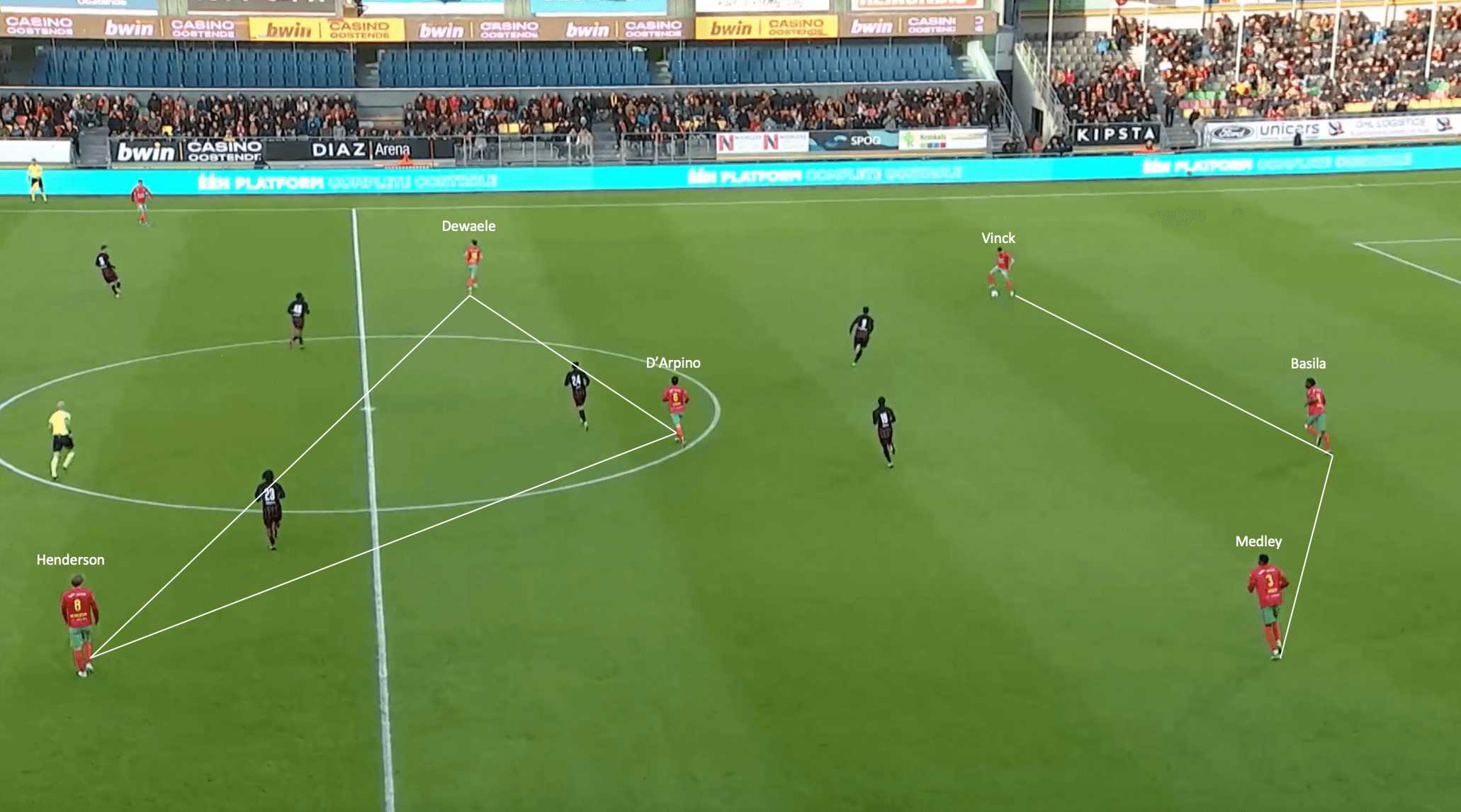
The image above shows an example of this attacking shape and the midfielders’ role in Shoffner’s system.
In this phase of play, we can make out the back three shape, with the ball currently in the possession of right-sided centre-back Jonas Vinck.
One thing to notice is how stretched the Oostende midfield is.
The three midfielders are almost the same distance apart as the three central defenders.
As we saw in the earlier graphic, Oostende does not often look to play between their midfielders, and the three in the centre of the park do not usually look to possess each other.
Instead, Shoffner uses them almost like bumpers, with them often playing bounce passes back to the centre-backs to draw the opposition defence up the field so the defenders can look to play long balls either centrally or into the wide channels.
This tends to explain the gaps between the midfielders when considering Oostende’s overall goal, which is possession, quick, and direct football.
As this in-possession phase progresses, Vinck plays the ball vertically to Sieben Dewaele, with the midfielder playing a pass back to the goalkeeper.
This pulls the opposition defence towards the halfway line
. The ball is then circulated out wide to former Chelsea and Arsenal youth product Zech Medley. The centre-back takesa touch before looking to play long towards the forwards.
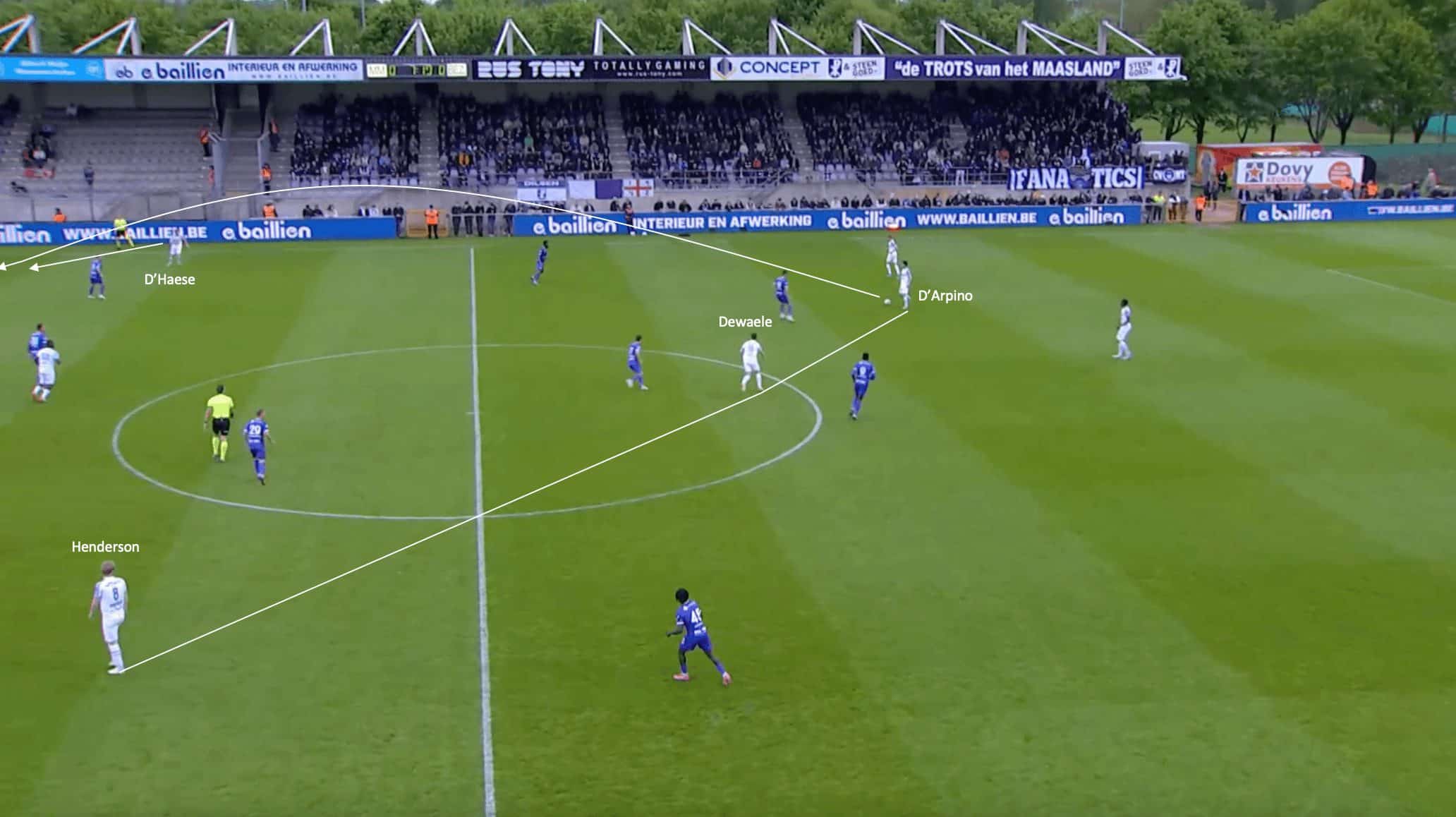
The image above shows an example of chance creation from Jamath Shoffner’s style of play and how the wide areas, and wing-backs in particular, are key to this.
In this phase of play against Patro Eisden, the ball is currently in possession of defensive midfielder Maxime D’Arpino, who gains possession right in front of the back three.
Notice again how stretched the midfield three is, especially the positioning of Ewan Henderson, who finds himself in the left half-space just inside the opposition’s half.
The midfielders in this Oostende side all almost act as free-roaming players.
The three tend to rotate constantly and interchange positions, looking to move into pockets of space anywhere in the middle third.
This type of midfield setup only really works if the end goal is to play more directly and quickly after gaining possession because (1) It would be hard to be possession-oriented with this type of fluid, free-roaming midfield, and (2) losing possession would likely result in devastating opposition transitional moments.
As this specific phase progresses, Robbie D’Haese, the right wing-back, will provide the width.
D’Arpino spots the run behind the wing-back and plays a ball over the top into his path.
D’Haese can get onto the end of the pass and drive into the penalty area, resulting in the goalkeeper mistiming his challenge and taking D’Haese down, giving Oostende a penalty.
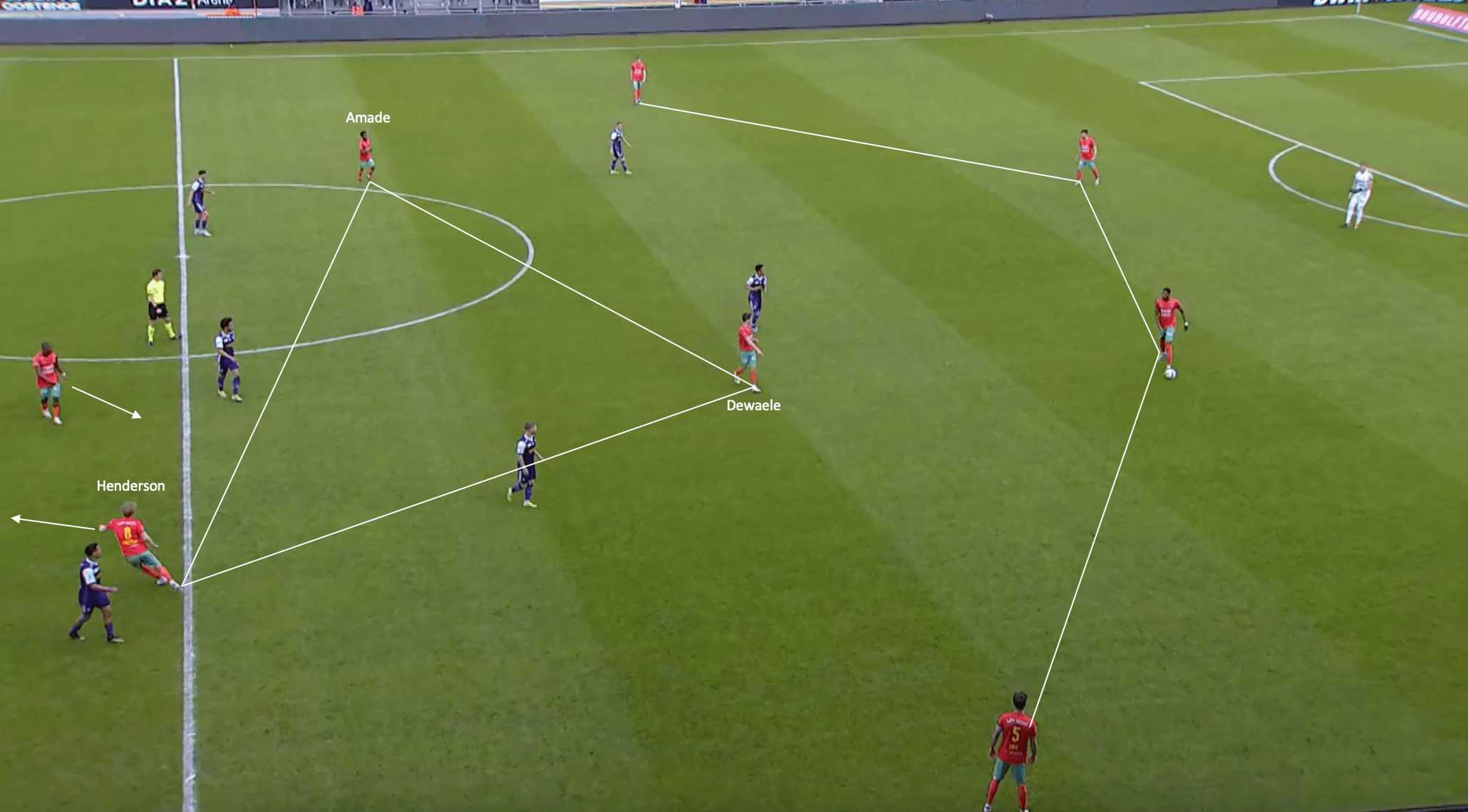
The image above shows something a little different for Oostende, at least in the way of formational shape.
In a few games under Shoffner this season, the Belgian side played in a four-back formation, and this match against Beerschot was one of those.
While the shape tended to look like a 4-1-4-1 in defensive phases of play, when Oostende was in possession, it looked more like a 4-3-3, keeping that similar midfield shape as in the back five systems.
The wide midfielders tended to tuck inside and form a more narrow attacking three with the central striker, with the width looking to be provided by the outside midfielders.
In this phase of play above, Henderson is the midfielder tasked with doing this.
As the ball reaches the centre-back currently in possession, the Scottish midfielder looks to make a run into the vacant wide channel.
The ball is played directly to him, but he fails to do anything with it.
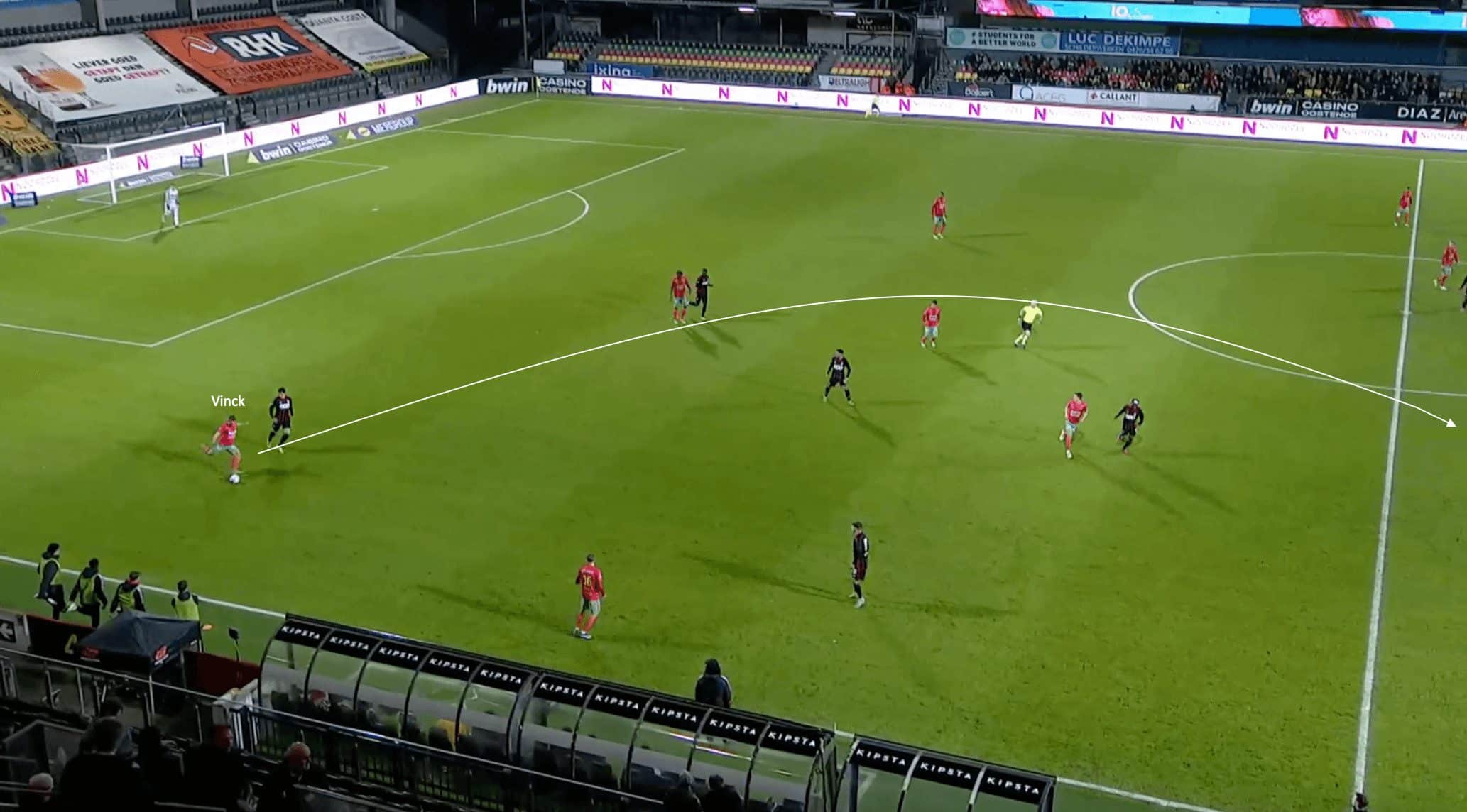
This last example consists of two images and provides a great picture of how Oostende has primarily sought to score goals under Jamath Shoffner.
In this phase of play above, Vinck has the ball.
The centre-back looks to play the ball long and into the half-space, towards where the forwards are looking to drop off slightly and into the midfield. The forwards want to win first balls in the air and flick them on to runners beyond them.
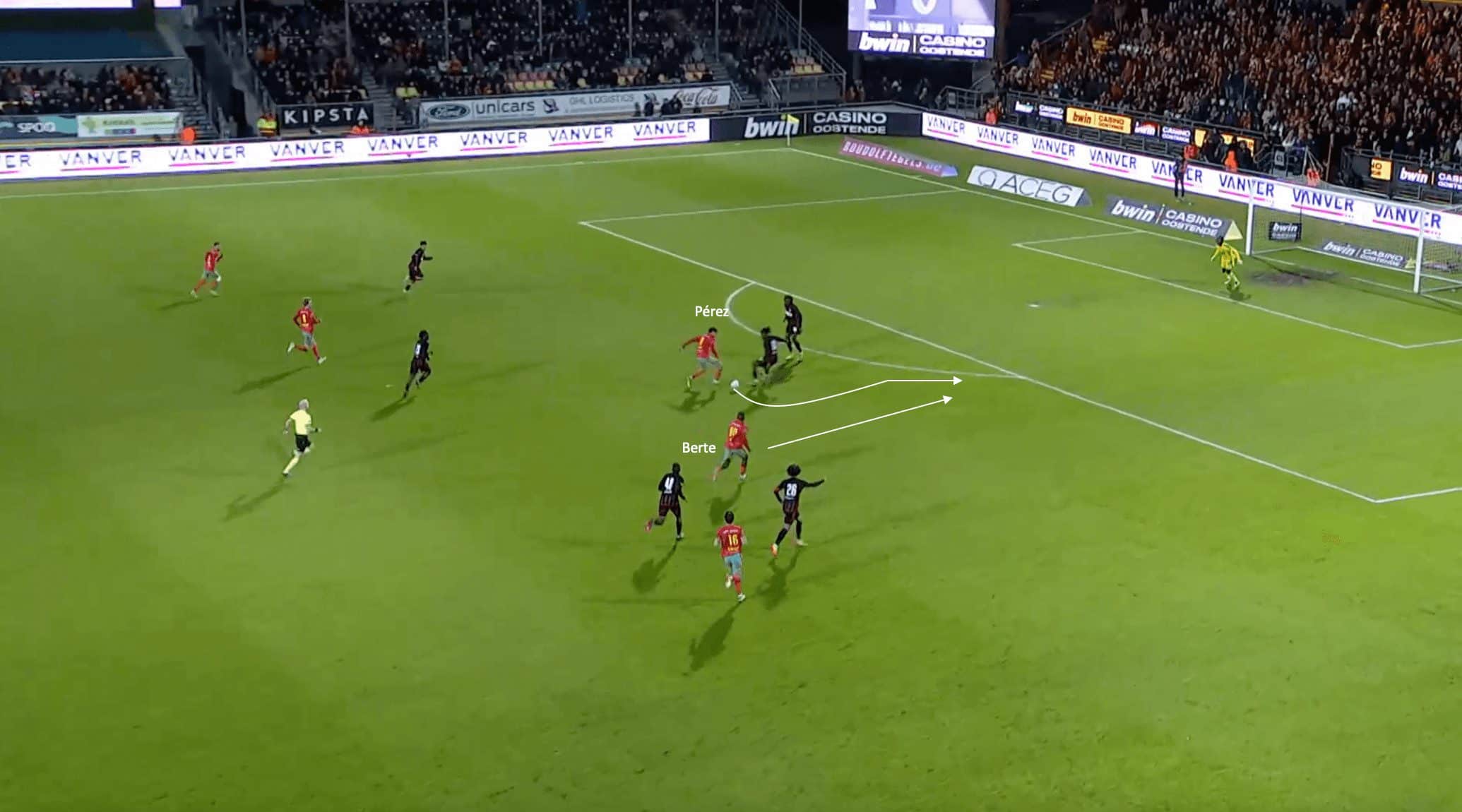
This next image shows how the attacking phase for Oostende develops.
The ball is played towards Mohamed Berte.
The 22-year-old forward is able to win the first ball in the air and flick it into the path of his strike partner, Daniel Pérez.
When receiving possession, the Venezuelan striker makes an out-to-in run, dragging the opposition defenders towards him and opening a gap for Berte to run behind into.
Pérez is able to play a ball into the 22-year-old’s path on his first touch, with the striker able to put the ball past the goalkeeper with a first-time finish.
In a total of three passes, the ball goes from the Oostende centre-back to into the back of the opposition’s net, highlighting the type of in-possession, attacking style that Jamath Shoffner has looked to implement in his first half-season at Oostende.
Jamath Shoffner Out-of-possession principles
Switching over to Oostende’s out-of-possession style under Jamath Shoffner’s tactics, one thing you can notice quickly once looking at the statistics and the data is that Oostende has been a side this season that is not afraid to get stuck in defensively.
KV Oostende Defensive Territory Map
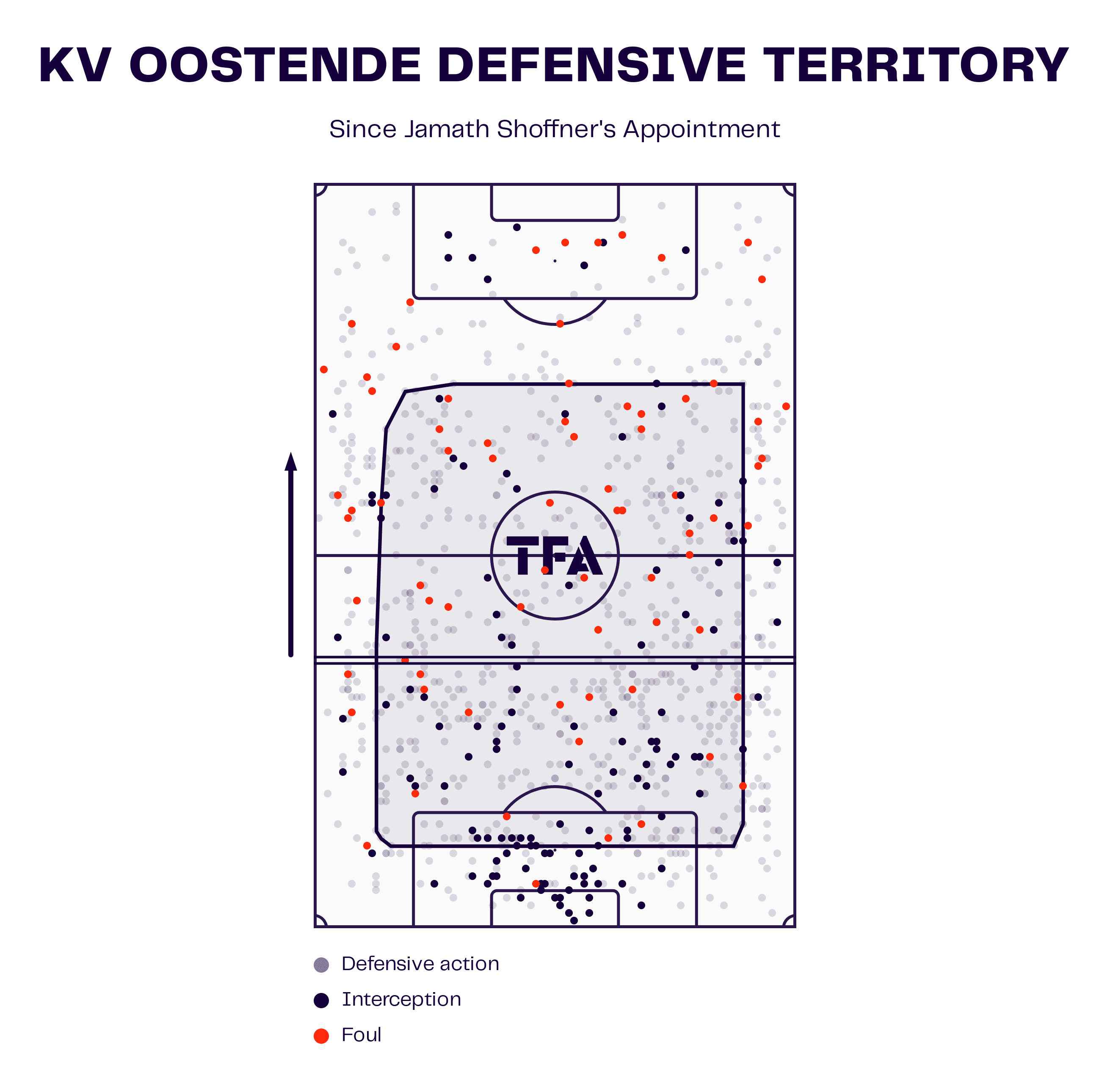
The data visualization graphic above shows the average defensive territory of Oostende since Shoffner’s appointment in January.
As we can see, Oostende is not an aggressive front-foot defending side under the American, with the seaside club not having many defensive actions in the opponent’s defensive third.
Oostende also doesn’t look to hold a high defensive line, with Shoffner’s side content to sit back in a low block 5-3-2 and look to be more aggressive in the tackle as the opposition reaches their half of the pitch.
From a more statistical perspective, Oostende has not been all that poor defensively this season.
Their 363 shots against is the fifth lowest in the Challenger Pro League for this term.
They have been involved in the most defensive duels, the second-most interceptions, and the third-most aerial duels, highlighting their willingness to commit to challenges.
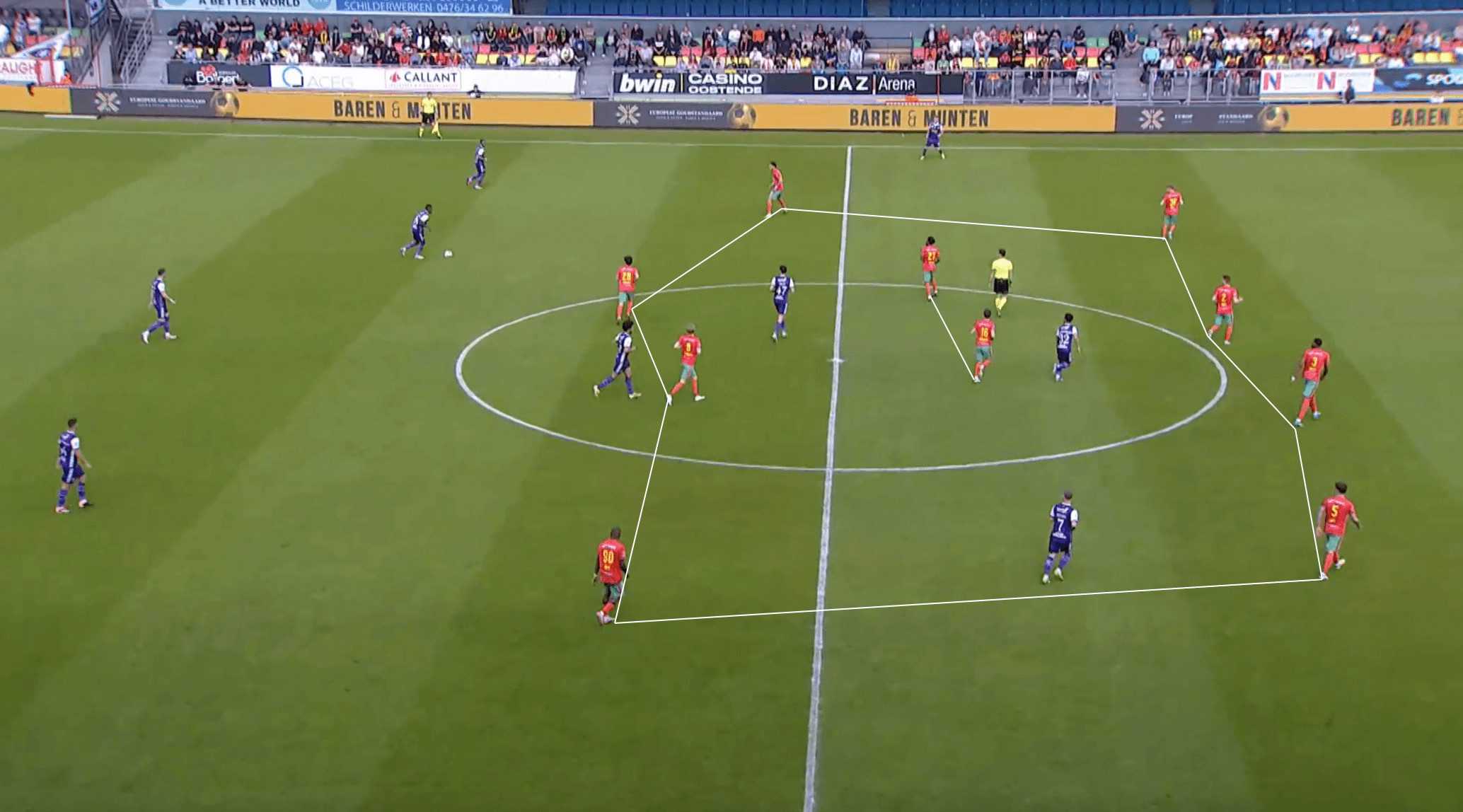
The image above shows a defensive phase of play for Shoffner’s side from their recent match against Beerschot.
To reiterate, this was one of the matches where Shoffner opted for a back-four formation, but the same defensive principles are still relevant.
Under the American manager, Oostende has sought compactness and numbers behind the ball, with this defensive phase being a great example.
As we can see, the shape looks similar to a 4-2-3-1, with the central striker dropping off and not looking to put any pressure on the defender in possession.
This is a common occurrence, with Oostende not looking to constantly disrupt opposition builds with high pressing and recoveries in the opponent’s half.
This does not mean Oostende will not press under Shoffner; their total PPDA of 9.47 in the 2023/24 season puts them in the top half of the Challenger Pro League in this metric.
KV Oostende High Regains Map
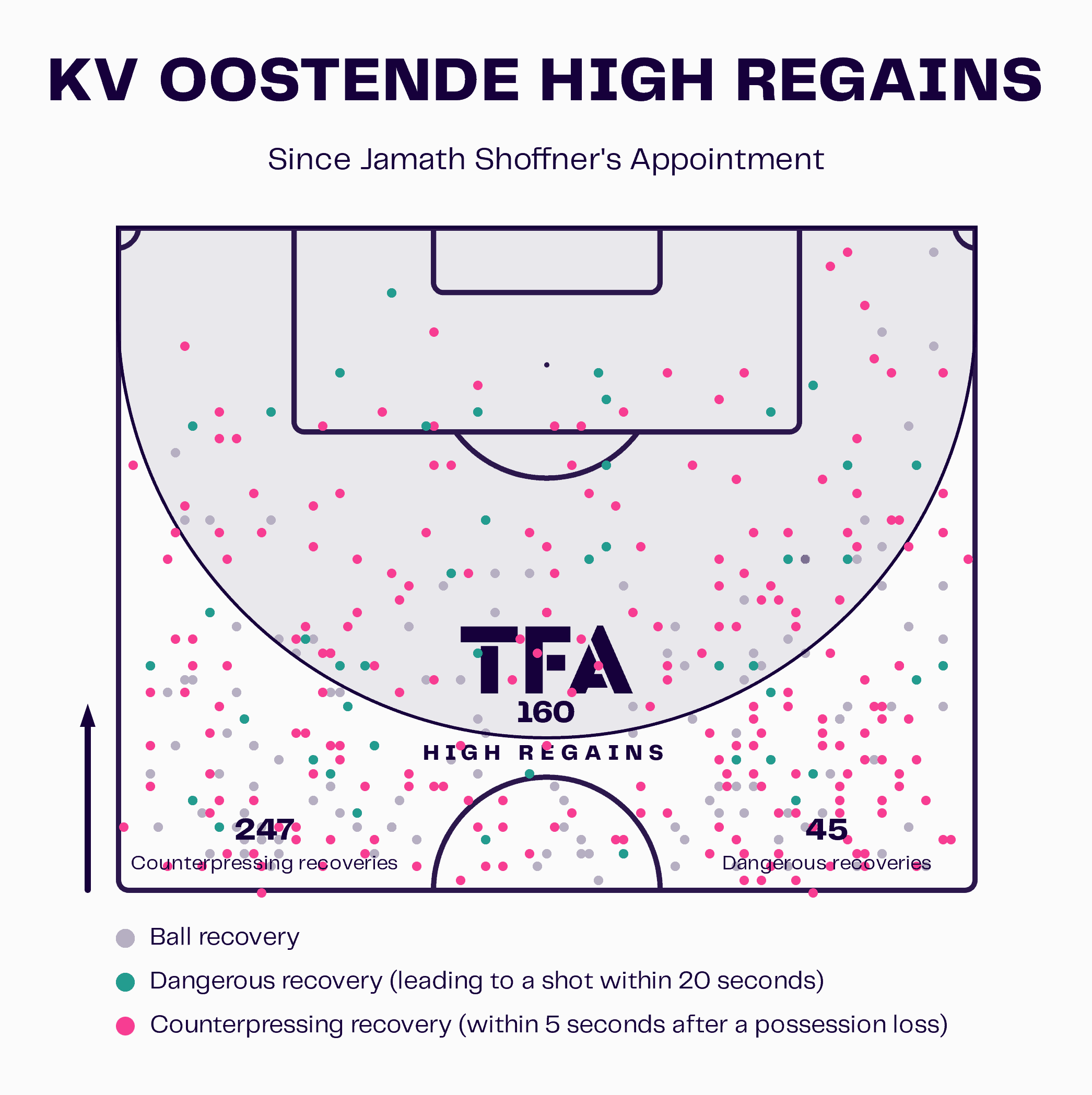
As just mentioned, while Oostende has been a side that has mainly looked to put numbers behind the ball and defend in a compact shape in the second half of the season, they have still looked to press at specific moments.
The graphic above shows Oostende’s high regains since Shoffner’s appointment, as well as their counter-pressing recoveries and dangerous recoveries.
One takeaway from this graphic is that most of these high-positioned defensive actions have occurred further away from the opposition’s goal.
The Oostende forwards do not look to press the centre-backs in possession right on the edge of their own penalty area, and Oostende’s press under Shoffner tends to be more strategic.
When Oostende do press, they do not tend to be super aggressive to the point where their defensive shape has the chance of getting pulled apart.
A lot of the time, they look to lock the ball to one side before forcing the opposition to play long and into the strength of this side defensively, their backline.
We have already looked over how statistically good Oostende have been from a defensive perspective this season.
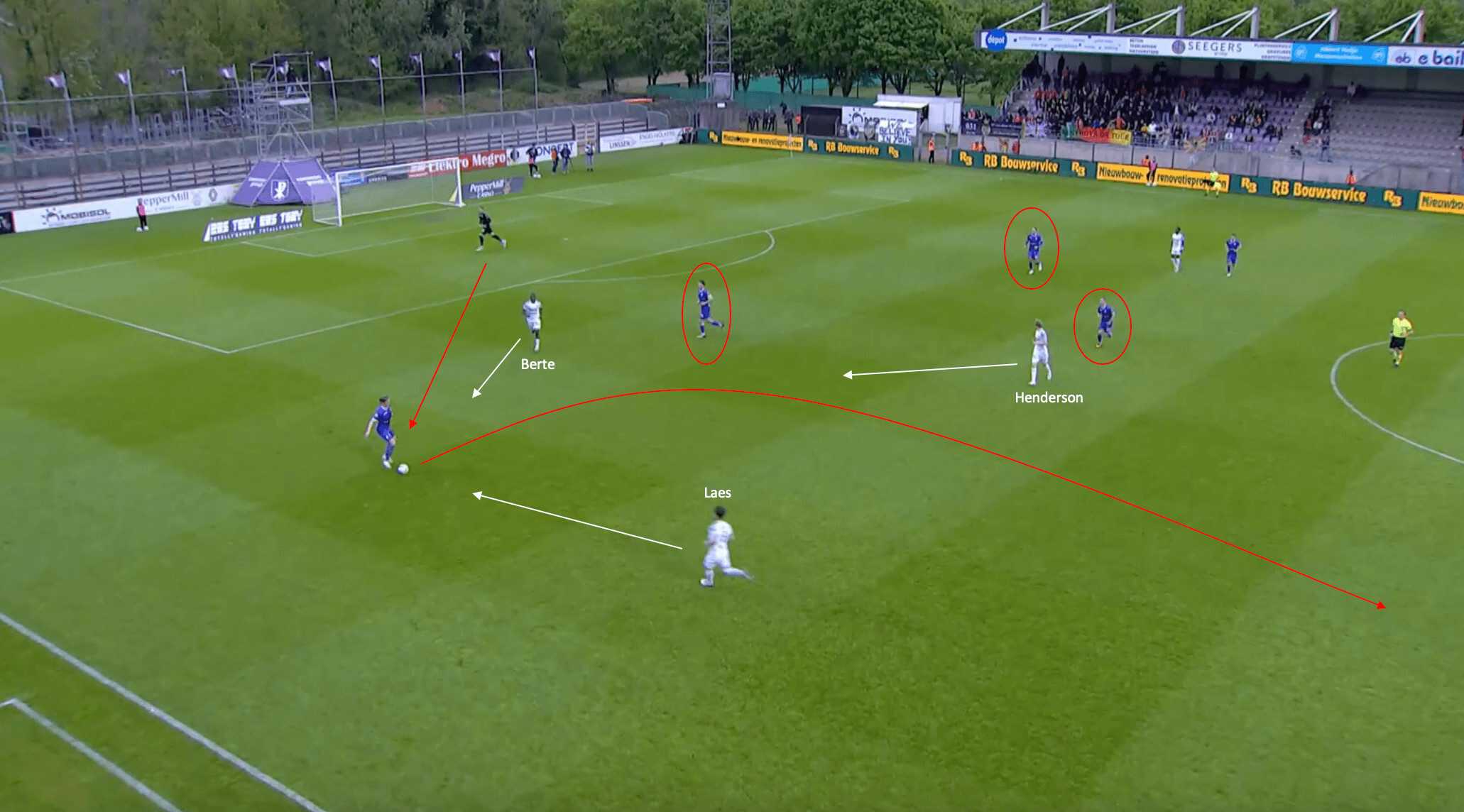
This phase of play against Patro Eisden is a good example of the strategic pressing strategy employed by Shoffner.
The Oostende forwards, Berte and David Atanga allow the goalkeeper time on the ball but look to prevent balls from being played centrally to the centre-backs, leaving the fullbacks open to receiving possession.
The goalkeeper distributes wide to the right back, which then triggers a semi-aggressive press.
Berte slides to force the fullback wide while also blocking off the passing lane to the central defender, while Henderson shifts into the pocket to prevent a switch of play into the central area.
Left wing-back Brent Laes advances high quickly, putting pressure on the defender and forcing him to play the ball long.
Oostende is able to gather possession and embark on a transitional attacking moment.
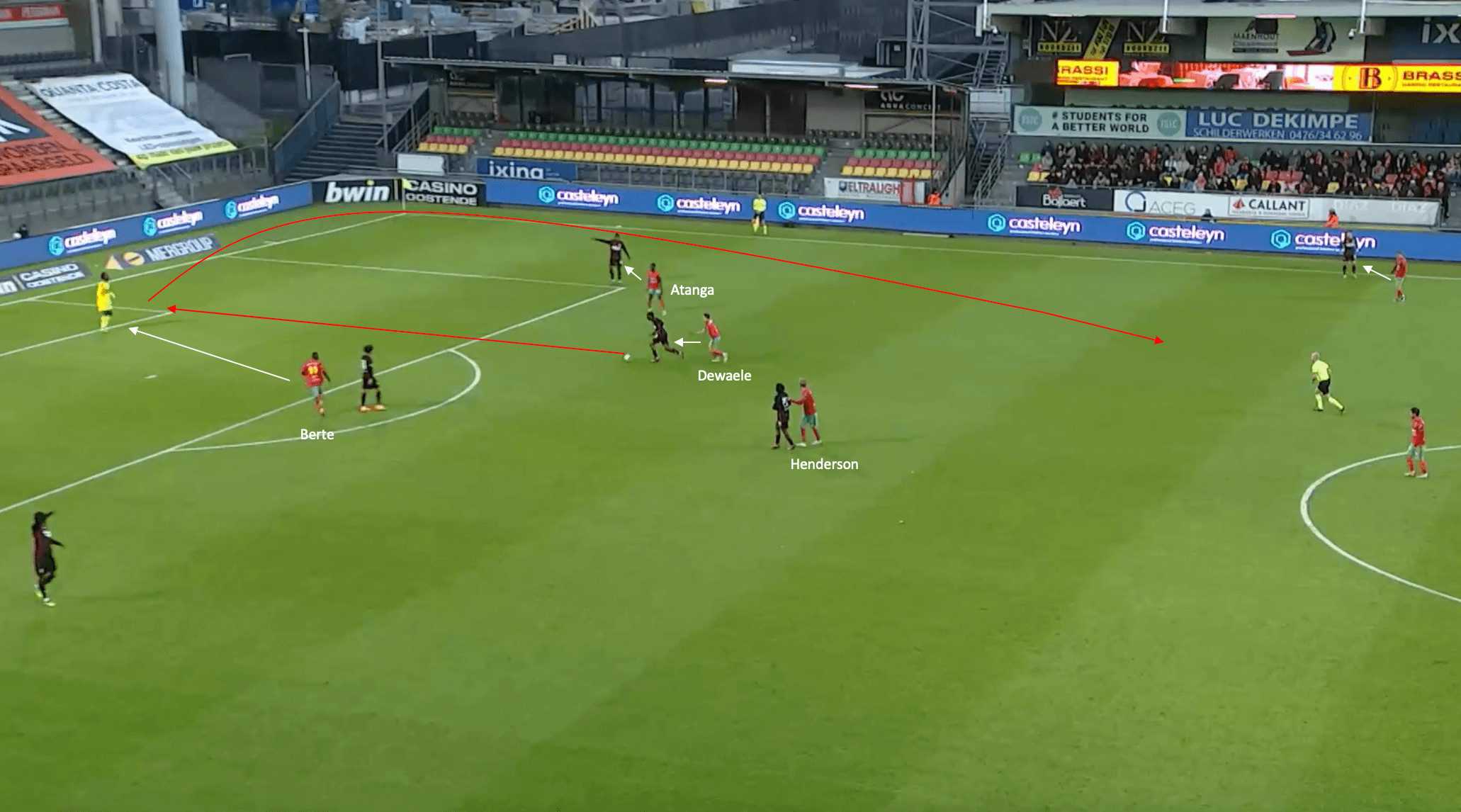
This is not to say that Oostende have not been more aggressive in their pressing since Shoffner’s arrival.
This phase of play above from their last league match of the season against Standard Liège II highlights this.
The opposition are looking to build out of the back, with the goalkeeper rolling the ball out to the centre-back.
As he receives possession, he is put under immediate pressure by Dewaele, with the midfielder forcing him to face his own goal.
This activates the rest of the Oostende press, and we can see the tight marking around the pitch from the rest of the advanced players.
With the centre-back’s body shape closed, his only option is to play back to his goalkeeper. Berte already anticipates this and begins to close the goalkeeper down.
This forces the goalkeeper to play long under immediate pressure, with his clearance only getting towards the referee.
This allows the Oostende midfielder in the centre circle to gather possession under no pressure and advance the ball vertically.
Conclusion
As this tactical analysis has illustrated, the club’s fortunes on the pitch have turned around under Jamath Shoffner’s manager style at Oostende.
With the Challenger Pro League season now concluded, Oostende have confirmed their second division survival.
Shoffner’s side is one to watch out for next season as they look to climb the table and potentially get promoted back to the Belgian Pro League.





Comments